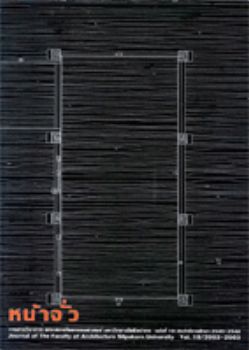วิวัฒนาการลานโล่งในเมือง: ไทยและเทศ
Abstract
งานวิจัยนี้ทําขึ้นเพื่อศึกษาเปรียบเทียบวิวัฒนาการลานโล่งของไทย ตั้งแต่สมัยอยุธยาถึงปัจจุบัน กับวิวัฒนาการของลานโล่งในยุโรปและอเมริกา ตั้งแต่สมัยกรีกจนถึงอเมริกาในปัจจุบัน ด้วยเหตุที่สภาพทางกายภาพของเมืองซึ่งมีลานโล่งเป็นองค์ประกอบหนึ่งนี้เป็นผลรวมของสภาพแวดลัอมทางธรรมชาติ เศรษฐกิจ สังคม การเมือง และวัฒนธรรมของแต่ละท้องถิ่น การพิจารณาสภาพกายภาพของเมืองจึงต้องทําควบคู่ไปกับการศึกษาสภาพโดยรวมทั้งหมดดังกล่าว ในที่นี้จะเน้นเฉพาะประเด็นหลักเท่านั้น ผลการศึกษาพบว่า การใซัลานโล่งกลางเมืองในลักษณะของลานพื้นแข็ง (square, plaza) ซึ่งเป็นองค์ประกอบที่คุ้นเคยกันในเมืองของยุโรปและอเมริกานั้น มิใช่องค์ประกอบของเมืองในประเทศไทย ไม่ว่าจะเป็นอยุธยาหรือกรุงเทพฯ (ซึ่งมีอยุธยาเป็นต้นแบบ) ผลรวมของปัจจัยต่างๆ ที่กล่าวแล้วของไทย ตั้งแต่สมัยอยุธยาจนถึงรัตนโกสินทร์ โดยเฉพาะก่อนสมัยรัชกาลปัจจุบัน ไม่อํานวยให้เกิดลานโล่งในเมือง ลานโล่งในเมืองของไทยที่เกิดขึ้นระหว่างรัชกาลที่ 1 – 8 มีเพียงสี่แห่งเท่านั้น โดยสามแห่งเกิดขึ้นจากพระราชดำริของพระมหากษัตริย์ หรือจากพิธีกรรมที่เกี่ยวเนื่องกับกษัตริย์ ลานที่เกิดขึ้นในย่านพาณิชยกรรมในรัชกาลปัจจุบันทั้งหมดสร้างขึ้นโดยภาคเอกชน มีการใช้งาน ที่เกี่ยวกับการค้าและความบันเทิงเป็นหลัก
Evolution of the Urban Plaza: Thailand and Western Countries
This research compares the evolution of the urban plaza in Thai cities, from the Ayutthaya period to the present time, with those in Western cities, from the Greek period to modern American. Since the urban form, of which the urban plaza is one part, is influenced by physical, economic, socio-cultural and political factors, their study should therefore take a holistic approach. However, only the most important factors are emphasized here. The study shows that the urban plaza, an element long associated with European and American cities, is not a ‘native' urban element of Thai cities. None of the above-mentioned factors supported the use of the urban plaza in Thailand, especially before the current reign. Only four plazas were established in Bangkok from the reign of King Rama I to that of King Rama VIII, and three of them were established either by the kings or to accommodate monarchic rituals. All the urban plazas in commercial districts of Bangkok were built during the current reign (since 1946), and all were built by the private Sector. They mainly accommodate commercial and entertaining activities.





